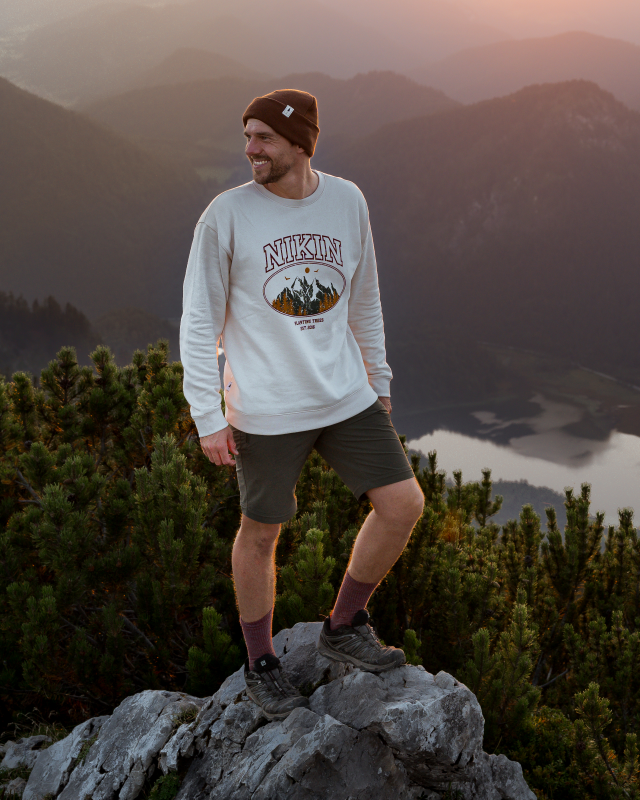Hiking can be so beautiful and it should stay that way - these tips will help you to pay attention to sustainability when hiking.
Hiking can be so beautiful and it should stay that way - these tips will help you to pay attention to sustainability when hiking.

Hiking is healthy and unabatedly popular. Currently, also due to Corona, more and more people are discovering spending time in nature and the many benefits for body and mind. The health benefits of outdoor physical activity are well known. You don't even have to be particularly fit to just get going and go on a hike too. The choice of hiking routes is so wide that the duration and intensity of the hike can be adapted to one's own needs - and you still cross beautiful landscapes. The physical activity and fresh air have a positive effect on the immune system, the joints and the circulation and take you to beautiful places in the countryside, often in the immediate vicinity.
Contact with nature has an invigorating effect, cheers us up and is a welcome counterbalance, especially for those who spend most of the day at a work desk and look at monitors a lot - especially in times of home offices. For families, hikes are great opportunities to do and discover things together and to teach their children about beautiful things that are beyond our consumer world.
Sustainable management of the environment
In doing so, however, one should also do something good for nature on one's part and behave as sustainably as possible when hiking. Unfortunately, you have to bring this up every now and then when you notice how parks and forests look after a particularly nice weekend. It's unbelievable that this still needs to be said in 2021, but clearly neither education nor common sense is of any use to some among us. Hence, sustainability insight number one right up front:
Rubbish produces more rubbish!
A single discarded aluminium can or crisps packet is enough to remove the inhibitions of those who follow. They throw their waste next to it and have a much less guilty conscience about it. That's why it's better to leave it alone!
It is best to avoid waste altogether
In the past, hikers were actually still advised to bury waste on the trail. Today we are smarter and that is why experts have now moved away from this, and also because many of our legacies degrade very badly and slowly. Plastic in particular remains for centuries - a baby nappy for about 800 years, until it has completely decomposed. Soils that are very thin and have little vegetation also have less soil life. There, it can take years for a paper handkerchief to dissolve.

Cigarette butts are particularly fatal. The filters do not dissolve and are often mistaken by birds for larvae - which they then feed to their young. If a filter gets into the groundwater, a single stub can poison thousands of litres of water and make it undrinkable.
Therefore: Use the designated bins, separate waste and - best of all - don't create any in the first place. Not being able to recycle properly is a cheap excuse in our area.
Quiet is mindful
But mindfulness involves much more than just handling and disposing of waste. Even the journey to hiking makes a contribution to nature conservation if we arrive by bicycle or public transport. Driving around in the forest in a noisy SUV is not only unsustainable, but also (dis)annoying. For other hikers - and for forest dwellers.
Do not disturb domestic and wild animals
Because we are not alone in nature. Most of the time we are surrounded by birds, insects and larger animals without noticing them. Those who move quietly and carefully sometimes have the opportunity to enjoy such encounters. Loud noises, music and especially leaving the hiking trails become a problem for animals. They feel harassed, and not all of them react by retreating. Wild boars with offspring can become aggressive in larger groups if things get too colourful for them, and even domestic sheep or cows on the pasture react irritably if they have young and hikers get too close to them - especially if you are out with dogs. Time and again, foresters find young wild animals dead that have obviously been snatched by domestic dogs. Therefore, it is better to stay on the paths - and always keep dogs on a leash.

Show consideration for plants
Not only the fauna is stressed if you don't behave sustainably, the flora suffers as well. Picking wild plants, which often wither before you return home, can simply be left alone. Photographing a beautiful flower is just as much fun and causes less damage. In this case, too, leaving the forest paths sometimes damages the sites of plants, often without even realising it.
Into the mushrooms best under guidance
Occasionally you want to go a little deeper into the forest, namely when mushrooms and berries are in season. There is nothing wrong with this, as long as you are guided by experienced pickers at the beginning. It almost goes without saying that mushrooms you have collected yourself should be examined again at the mushroom testing centre before they go into the pan.
Be prudent with fire
In view of the increasing climatic changes, which also put a strain on nature, especially persistent drought in summer, the last important note should be about making fires in nature. Having a picnic outdoors, even barbecuing, can be very nice - at designated places. Afterwards, the fire should be thoroughly extinguished before leaving the place.

Most of the tips should not be new and are actually based on common sense. And now have fun on your next adventure!
Most of the tips should not be new and are actually based on common sense. And now we wish you lots of fun on your next adventure! By the way: With the new products from our Hiking Collection you'll be well equipped for your next hiking adventure.




















